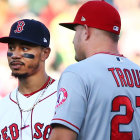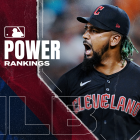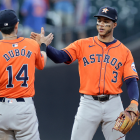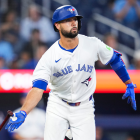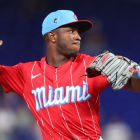Bryce Harper's $330 million contract with the Phillies doesn't give him the highest average annual value or even the highest overall value once you adjust for inflation. It is, however, the highest total dollar figure ever guaranteed to an MLB player, and that's what we tend to talk about when we talk about record contracts.
Harper's pact broke the previous record set by Giancarlo Stanton, when he inked a $325 million extension with the Marlins prior to the 2015 season. Prior to that, Alex Rodriguez's $275 million deal with the Yankees, signed in late 2007, was the biggest, and prior to that it was A-Rod's $252 million contract with the Rangers. This, though, is about more than who will "merely" be the one to break Harper's freshly minted record. This, rather, is about who might be the first to crack the $400 million mark.
It's entirely possible that MLB's first $400 million man isn't presently playing baseball at the highest level. Maybe he's a prospect, or maybe he's even still an amateur. Given the usual rates of inflation, though, it's more likely that the first to $400 million has already proved his mettle in the majors. With that in mind, let's take a quick look at the leading candidates to become that first $400 million player.
The heavy favorite
Mike Trout is the best player in baseball, and it's not a particularly close call. He's played seven full seasons in the majors, and over that span he's finished no worse than fourth in the AL MVP balloting. His unthinkable total of 64.3 WAR through age 26 is the highest ever for a position player, just ahead of Ty Cobb (63.4). In terms of OPS+, his worst seasonal mark is 168, which came in 2014, his first MVP season. He's the best hitter in baseball, he's a plus defender at an up-the-middle position and he adds value on the bases. You can easily exhaust the superlatives when talking about how dominant Trout is.
The only thing that makes this any kind of a guessing game is that Trout, thanks to the $144.5 million extension that kicked in prior to the 2015 season, pushed his free agency back until after the 2020 season. That's when he'll be going into his age-29 campaign. Obviously, a major driver of free agent worth is age. Teams these days are focused on what a player projects to do moving forward, and past performance matters only to the extent that it informs future expectations. This didn't always seem to be the case. Harper and Manny Machado made a lot of money this winter because they're excellent baseball players, but they also made a lot of money because they're uncommonly young for free agents. Trout, had he not inked that extension, would've hit the market after his age-25 season, as Harper and Machado did. Were that the case, he'd likely already be our $400 million man.
Things as they are, though, Trout's going to need to show customary excellence over the next two seasons, while also avoiding the injuries that affected him in 2017 and 2018. To be sure, there's no reason to expect anything like a premature decline with Trout, and his broad base of skills in tandem with his conditioning and elite athleticism bode well for the long-term future.
To set a baseline, here's this recent dispatch from The Athletic's Ken Rosenthal:
In recent weeks, the Los Angeles Angels at least considered offering Mike Trout a 10-year, $350 million extension, though it is unclear whether they followed through with an actual proposal, according to sources with knowledge of the club's thinking.
A deal of that size would be the biggest in the history of North American sports and give Trout the highest average annual value ever for a baseball player.
And still, it would not be nearly enough.
"Not nearly enough" is the key takeaway here. Yes, Trout will be coming off his age-28 season when he hits the market, but his historically singular level of production -- provided it's mostly sustained in 2019 and 2020 -- plus two years of inflation mean he's the safest and surest bet to become the first player to sign for $400 million or more.
Other contenders
Reigning AL MVP Mookie Betts will hit the market when Trout does, after the 2020 season. While he doesn't compare to Trout in terms of overall value to date, he's more than a full year younger. As noted, age is a big driver of free agent valuations.
Betts is going to get paid in a big way assuming he hits the market on schedule. Whether he can sustain the offensive gains he made last season will determine whether he can command $400 million or more. Coming into 2018, Betts boasted a career slash line of .292/.351/.488, which is strong production given how good he is in the field and on the bases. Then, though, he leveled up with a line of .346/.438/.640 last season. When it comes to Betts' 2019 expected wOBA (more on that metric can be found here), he does seem to have mostly earned those gains. If Betts can come anywhere close to showing that level of performance at the plate is repeatable, he's going to threaten or surpass the $400 million mark in the winter of 2020-21.
Alex Bregman is going into his age-25 campaign, and he's seen an impressive upward trajectory across his brief big-league career to date. Bregman's a standout defensive third baseman who's also capable of manning shortstop, and he combines power and patience with good contact rates. He enters the 2019 season with more than two years of major-league service time. That means Bregman is on target for free agency following the 2022 season. At that point, he'll be going into his age-29 season. While he won't be notably young as free agents go, he'll still be on the right side of age 30.
Straightaway, four years of salary inflation will be working in Bregman's favor. The key will be continuing that upward trajectory or at least plateauing. Players these days tend to arrive in the majors must closer to peak level than they did in the past, so you always worry about premature decline. For Bregman, insofar as $400 million is concerned, he'll need to show that 2018 wasn't a peak for him -- at least not a peak he comes down from within the next half-decade or so.
On another level, Bregman is our first candidate who won't be a free agent under the current collective bargaining agreement (CBA). The current CBA, which governs the working relationship between labor and management, will expire on Dec. 1, 2021, and by the time Bregman hits the market a new agreement with be in force. Given the level of player distaste for the last two free agent markets, along with the MLBPA's failure to address salary issues in the current CBA, the next one will likely look very different. It remains to be seen how negotiated changes will affect the free agent market, but it seems likely that the landscape will be altered significantly in some way or another. Perhaps players will become eligible sooner, or maybe some kind of restricted free agency will be instituted. Whatever the specifics will be, bear in mind that we're dealing with a lot of market unknowns when we talk about players who'll be free agents under the next CBA.
Bregman's teammate Carlos Correa is slated to hit the market after the 2021 season, which means he'll likely be under the new CBA as well. He'll be only 27 when he becomes a free agent, which will work in his favor. Correa needs to do three things in order to establish himself as a $400 million-ish player:
- Demonstrate sustained health
- Stick at shortstop, or at the very least wind up at third base
- Prove his 2018 decline at the plate was a fluke
The latter is especially key. Across his first three seasons in Houston, Correa authored an OPS+ of 137, but last season that slipped to 102. While that's still strong production for a shortstop, it's not what he needs to land such a contract. Correa needs to get back to his pre-2018 self at the plate, and also stay healthy (he's played 109 and 110 games in each of the last two seasons, respectively).
Francisco Lindor is slated to be part of that 2021-22 free agent class alongside Correa. Right now, he figures to have a stronger market than his Houston shortstop counterpart. Lindor is elite defensively at the position, and for his career he's averaged 28 home runs, 39 doubles, and 20 stolen bases per 162 games played. To boot, he's averaged more than 158 games played per season over the last three years. Lindor's coming off a career year in 2018, which raises the tantalizing possibility of an upward trend with the bat.
If he sustains his defensive value and power capabilities over the next three seasons, then he's going to be in that $400 million discussion. If, however, Lindor begins to see some decline in the field (defensive ability is one of the first skills players shed), then he may slip from "great" to "very good" in the eyes of the market.
The next generation
Presumptuous on our part to include a 20-year-old in the discussion? Maybe, but Ronald Acuna is a special player already. Indeed, you can already put him in the discussion for best player in the National League. In his age-19 season, Acuna put up an OPS+ of 144 with 16 home runs and 16 stolen bases in 111 games. Those numbers are backed up by a deeply impressive minor-league dossier and glowing scouting reports dating back to his early teen years. Simply put, he's a generational talent who hasn't shown any kind of learning curve at the big-league level.
The Braves conveniently delayed Acuna's promotion to the majors last year, so he's still shy of one full year of service time. That, in turn, means he won't be eligible for free agency until after the 2024 season, when he will be going into his age-27 season. That's a lot of time for salary growth, and if Acuna performs as expected or close to it, he's going to command more than $400 million. However, we may cross the $400 million mark before Acuna is a free agent.
Juan Soto isn't quite as tooled up as Acuna, but a .292/.506/.517 line as a 19-year-old is extremely rare. His power profile suggests future greatness. Soto will be a part of that 2024-25 class with Acuna, and he'll be at a similar age. He's not the defender or baserunner than Acuna is, but Soto's plate skills will mean he's a coveted free agent, provided his career unfolds as expected.
The wild card
As implied by the hitter and pitcher profiles above, Shohei Ohtani is a vaunted two-way talent who made a big impact for the Angels last season. On the mound, he flashed elite velocity. At the plate, Ohtani proved to have big-time power. He won't pitch in 2019 after undergoing Tommy John surgery, but he should resume his role as the Halos' DH as early as May.
Ohtani racked up a full year of service time as a rookie, and that means he'll be eligible for free agency after the 2023 season -- i.e., after his age-28 campaign. If Ohtani continues putting up big power numbers and remains a difference-maker on the mound, at least on a part-time basis, then he'll be highly coveted. Of course, Ohtani will need to show arm health and succeed across a larger sample size, but the potential to provide such broad-based value from a single roster spot makes him one to watch. We'll probably get our $400 million man before Ohtani becomes a free agent, but in the event that we don't... he could pull it off before Acuna and Soto hit the market.
As in all things baseball, though, put your money on Mike Trout.
























